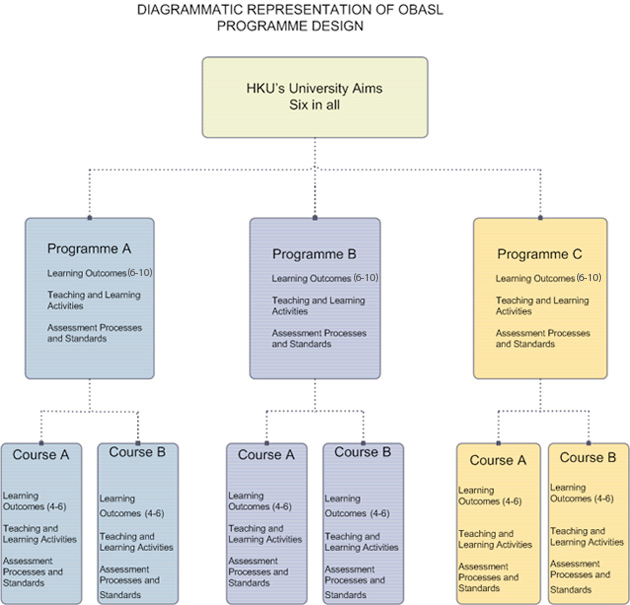Outcomes-Based Approaches to Student Learning
What is OBASL?
OBASL is an approach to programme and course design, and to teaching and learning, that is focused upon what the students are expected to learn and to do, rather than what the teacher expects to teach and do.
OBASL at HKU
The University responded positively to a suggestion from the HK UGC that programmes of study should become outcomes-based. The University subsequently resolved to adopt an outcomes-based approach in the design of the new 4-Year Curriculum. In implementing an OBASL, the University intends it to address the issues for improvement identified in recent surveys of students’ experiences of studying at the University. The aim is to better establish a teaching and learning environment in which students will engage more deeply with their studies, and in which the University is better able to provide evidence that the students are learning what it is they are supposed to be learning.
What is a Learning Outcome?
A Learning Outcome is a clear statement, written from the student perspective, of what we intend that our students are able to do at the end of the programme or course. Learning Outcomes are not numbers of graduates, numbers of students, teaching and contact hours, student staff ratios etc. These are outputs.
The first stage in developing an OBASL programme is to identify the Programme Learning Outcomes – what a student is expected to be able to do at the end of their programme of studies. The University has identified a set of University Aims, Faculties are developing Programme Learning Outcomes aligned with the University’s Aims for each of their programmes. Each course will then develop a set of Learning Outcomes (4-5), with 2 or more related to the Programme Learning Outcomes.
Learning Outcomes, Teaching and Learning Activities, Assessment Procedures and Standards, and Constructive Alignment
Having identified the course Learning Outcomes, the next step is to review, revise, develop Teaching and Learning Activities explicitly related to each Learning Outcome. For example, if a Learning Outcome is that students will develop the ability to solve particular types of problems, lecturing students about how to solve such problems will not be sufficient. Students will need practice, support and feedback in solving such problems.
Once the specific Teaching and Learning Activities are identified that will help students achieve the Learning Outcomes, the next step is to review, revise, and develop Assessment Procedures aimed at assessing the learning outcome. Again, if a Learning Outcome is that students will develop skills in oral communication, then asking students to write an essay about oral communication does not assess the Learning Outcomes. Students need to engage in an act of oral communication which is assessed.
Having identified the Assessment Procedures, Assessment Standards of performance need to be developed. This may be a generic statement at the Faculty or Programme level. For example, a programme might define an ‘A’ as showing evidence of original thought or being able to critically analyse evidence etc, but a ‘D’ as being able to reproduce what was taught with no evidence of critical analysis or original thought. Each grade needs to have a grade descriptor, describing explicit differences between the grades. Grades are meant to describe what students can or cannot do rather than how their performance compares to other students.
Finally, a course description will be developed for students in each course, detailing the Learning Outcomes, Teaching and Learning Activities, Assessment Procedures and Standards and their alignment.
Programme, Course and Teacher Evaluation
The major forms of evaluation will include a mapping of the Programme Learning Outcomes against courses to ensure that all programme Learning Outcomes are addressed in at least some of the courses. Teachers will be asked to maintain samples of students’ work judged to be of high quality and of low quality.
HKUSLEQ (formerly HKUCEQ) will be the main form of student evaluation of programmes. The HKUSLEQ includes items on the achievement of the University Aims and the student experiences of the programmes as a whole. The courses and teachers will be evaluated by the revised SET evaluation.
This will include items on students’ perceptions of the clearness of the learning outcomes, their achievement of the learning outcomes and their perception of the quality of the course and teaching in the course. There will also be Alumni and Employer surveys of our graduates, and their perceptions of the outcomes.

Summary of Stages in the development of an OBASL programme and courses
- University defines University Aims (UAs)
- Faculties define Programme Learning Outcomes (PLOs) aligned with UAs
- Faculties define Assessment Standards in the form of Grade Descriptors
- Teachers define course Learning Outcomes (LOs) aligned with PLOs for their courses
- Teachers review / revise / develop Teaching and Learning Activities (TLAs) clearly aligned with LOs for their courses
- Teachers review / revise / develop Assessment Procedures clearly aligned with LOs
- Teachers adopt or adapt Faculty Grade Descriptors to define Assessment Standards for their courses
- Faculties map the relationship between PLOs and LOs
- Teachers ensure students understand the LOs, TLAs and Assessment Procedures, Assessment Standards and their alignment
- Teachers maintain samples of student work
- SET evaluates teachers and courses
- HKSLEQ evaluates programmes
- External Examiners evaluate programmes
Readings and Downloads
- Michael Prosser. A Short Guide to Outcomes-Based Approaches to Student Learning at HKU
- Michael Prosser. Grade Descriptors and Standards
- Michael Prosser. OBASL Overview
- UGC Symposia. Outcome-based Approaches in Student Learning
- John Biggs and Catherine Tang. Outcome Based Teaching and Learning – What is it, Why is it, How do we make it work?
- Peter Ewell. First Report to UGC
- Peter Ewell. Second Report to UGC



